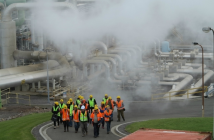The adoption of mobile devices continues to grow in everyday working life, notes marketing executive Greig Duncan.
It is predicted that by the end of this year the total number of mobile phone users will rise to 4.47 billion globally.
This trend is particularly dominant with those working in remote conditions and in environments with little or no access to IT infrastructure.
Sectors with remote working conditions are experiencing significant growth in the adoption of smart devices to increase quality, efficiency and accuracy of safety data gathered.
To address these changing market conditions, technology companies are altering their priorities in terms of application development and driving innovation in this area, with many safety applications now geared towards being usable on mobile phones and tablets.
Due to the mobility of the workforce – sometimes in remote locations, with no desktop access in industries such as engineering and construction – this method of logging business critical information both online and offline has represented a step change in operational efficiency.
Improved efficiencies in recording and managing safety investigations, by making use of modern technology, will allow the responsible managers and workforce to record safety incidents and the flexible use of business process workflow software.
A recent survey conducted by the Public Relations Society of America of over 300 business professionals has revealed that 90 per cent of respondents believe that mobile applications are an effective method of peer-to-peer workplace communication and logging of information (such as safety incidents, content repository and auditing).
However, there is evidence that the transportation sector is leading the way in application development, for example in accommodating tickets through smartphones.
Customers are also able to display the ticket on screen as a barcode that they can buy and board, removing the need to queue at the station, a trend also witnessed with boarding passes within the aviation industry.
With compliance towards safety standards, such as ISO 9001, BS OHSAS 18001 and the forthcoming ISO 45001, this is a key development within a range of business sectors, such as manufacturing and automotive.
ISO 45001 (which has been delayed and now anticipated in 2018) builds on the recommendations for top-down leadership on health and safety by making this an actual requirement.
Clause 5 will require board level management to demonstrate leadership, commitment and promotion of a positive health and safety culture.
This new standard also moves to make companies think about the steps they are taking to improve and communicate health and safety from C-level down to grassroots level.
One major problem with employee engagement to date has been the pervasiveness of blame culture and a resistance to change – doing things how they have always been done.
So even if people do see something and even if it’s easy for them to report an incident or occurrence, employees are worried about being labelled as a troublemaker.
This has been overcome in many industries with the invention and rollout of confidential reporting systems and improving safety-driven cultures – particularly evident within highly regulated industries, such as oil and gas, where there is no compromise on safety.
Smart devices are making it easier to engage people and contractors, a view which is supported by Air Transat’s Senior Director of Safety, Quality and Security, Dave Bourdages.
“Smart and mobile devices make logging data a lot easier and assist in gathering information and limiting our risks as an airline – regardless of where our staff are in the world,” he explains.
“The backbone of every Quality and Safety Management System is to be fed by the employees and to allow us to analyse KPIs at board level.
“The more data and information we can gather makes us more proactive and helps us to build better barriers and to diminish and prevent risks as an airline.
“We are using technology day-to-day in our everyday lives and in the workplace in every role – pilots, flight attendants and ground staff.
“Most people have a smart phone, tablet or phablet, this trend is part of the natural evolution of the airline, which will allow us to be more efficient and will allow us to report and treat the data more rapidly.
“I believe that new technology takes Air Transat to the forefront of the industry from a safety database standpoint.”
The United Kingdom’s Rail Safety and Standards Board (RSSB) has recently undertaken significant steps to roll out their new SMIS+ (Safety Management Information System) to log industry-wide close calls, safety incidents and tracking investigations.
A notable part of making the system accessible is the use of mobile applications and smart devices.
According to the RSSB, one of the key rationales behind this shift is that “Safety incidents can be captured in real time via mobile devices and processed seamlessly, so that the right incidents are investigated by the right people at the right time.
“These events could be geographically tagged, stored with relevant pictures and documents, and automatically alerted to those who need to know, when they need to know.”
Whilst safety standards on the whole are statistically improving across the global rail sector, (there has been an annual reduction of just under 10 per cent), the majority of recent high-scale and fatal safety incidents (such as Bad Aibling in Germany, the Santiago de Compostela derailment in Spain and Dalfsen in the Netherlands) could possibly have been avoided with more robust safety logging.
Taking the lead from other safety-driven industries, such as aviation and oil and gas, to roll out and adhere to industry-wide standards and directives could yield positive results.
While these industries do not have a fault-free record in terms of safety, these shared standards have helped to promote a collective understanding of a “safety culture” and a responsibility for safety, quality and risk reduction – much of which has been achieved through collaborative and standardised software utilisation.
This benefits global firms from a practical reporting aspect, as data gathered is up-to-date and accurate – allowing the firm to identify threats and put appropriate safety controls in place to reduce risk.
Ross McLarnon, enterprise software product manager at Ideagen PLC, sees the development of smart device-oriented technology as a positive thing for the transportation industry.
“Whilst the development, acceptance and implementation of new software tools and technologies cannot be achieved overnight, the future of such technology will continue to deliver enhanced benefits.
“There is a definite growth in the number of companies using mobile applications, software, and smart devices to take a risk-based approach to operational excellence that drives quality, compliance and safety, allowing their respective firms to improve and become more accountable and mature.
“Robust and innovative software and communications is at the heart of pulling all the information into analytics and reports for a single version of the truth.
“At Ideagen, a key feature in achieving successful implementations – with the likes of Air Transat, HAECO, IAG, Ryanair and the RSSB – has been the in-app communication capabilities, which has allowed all dialogue related to a certain incident to remain within the application – reducing email dialogue and retaining incident accuracy.
“This trend is something that has crossed the barrier from social media to workplace applications, with it already being commonplace within the likes of Facebook.”
The development of software applications and smart forms in this arena will continue to change the way in which people undertake their daily tasks.
For generations, spreadsheets and hand-written documentation have added a significant amount of effort to the daily tasks of staff within the majority of industries.
The introduction of elastic searching and smart forms has helped overcome this by intelligently calculating which form is relevant in the workflow and which forms are not applicable – significantly speeding up the process of auditing and safety incident reporting.
Seamless integration between quality and safety systems and real-time monitoring of safety-critical equipment ensures for a live feed of data to proactively flag when any thresholds have been breached.
This has moved the industry forward in terms of developing software that means that incidents can be confronted immediately and not retrospectively following an incident or tragedy.
As business intelligence, analytical data, mobile software applications and smart devices continue to dominate everyday working life, combined with the current high speed of technological development, this adoption trend looks set to continue, both in and outside the workplace.
With the capture and analysis of big data becoming an active part of our everyday lives, this trend looks set to continue… the future is now.




